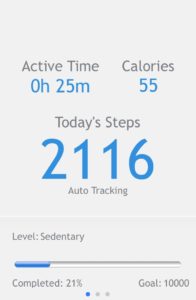Pacer results
I’ve walked 2116 steps with Pacer today! #Pacerstats http://t.co/02Oc7HeZcK. This is a great app that runs in the background on your smart phone.
 The App called Pacer is installed on my iPhone and apparently makes use of a chip on the iPhone called the A7. it is geared to measuring motion and also using GPS data to help measure how many steps are taken by the person carrying the iPhone. This is a little known feature that seems to work quite well based on several months of use.
The App called Pacer is installed on my iPhone and apparently makes use of a chip on the iPhone called the A7. it is geared to measuring motion and also using GPS data to help measure how many steps are taken by the person carrying the iPhone. This is a little known feature that seems to work quite well based on several months of use.
It is not totally accurate. But it is certainly within the proper level of accuracy for users to feel confident about tracking the amount of activity each day. I noticed that when I am biking, pacer keeps track of how far I have traveled although I have no idea if it is accurate or not. The results for the day tend to skew the results for the week and all trends. Bottom line though is that it is recording activity which is really what I am after with it.
Pacer results – Location of the iPhone
According to the APP documentation, there is no right or wrong place to wear or carry the iPhone. What we have found over the past week or so is that it does seem to make a difference regarding where you wear it. Although I have yet to find the sweet spot in terms of where to carry the iPhone, it is working and seems to measure about 90% of the steps. You can also track blood pressure, heart rate and keep track of all of these measures to help manage your over all health. I tend ot just carry the iPhone in my pocket and it seems to work just fine. The battery does seem to go down fairly quickly because I have the GPS turned on which apparently not necessary for the chip to work and deliver results of my days activity.
If you have used this app and have comments, let us know what you think and any hints you might have regarding how to improve accuracy of the APP. Apple products are getting better and better all of the time. For more information about pacer results and getting exercise, click here.
You can follow any responses to this entry through the RSS 2.0 feed. You can leave a response, or trackback from your own site.


October 24th, 2015 at 7:51 am
CPAPs are one HCPCS code which includes APAPs. BUT bi-levels have difenrfet HCPCS codes for the various types of advanced therapy they provide. So there are more than two types of PAP devices.I mentioned the no mask typo earlier. There is a brand name NoMask mask but it doesn’t fit into your reference descriptions.Full face masks come w/adjustable headgear just as all the PAP masks that I know of do.Nasal cushion masks do NOT cover the mouth. Nasal pillows do NOT cover the mouth. The oro-nasal masks such as the Resmed Liberty do. To the best of my knowledge there are 4 styles of mask, each style having its own HCPCS code: full face, nasal cushion, nasal pillows and oro-nasal. I’m not sure yet whether there will be a separte HCPCS code for the new Respironics FitLife mask yet or not.There is at least one, and I think two, relatively new PAPs, one each from Resmed and Respironics, that were developed specifically for Cheyne-Stokes and central apneas. The Resmed Adapt SV comes to mind.PAP pressure is NOT at all dependent on the severity of one’s sleep apnea. Many w/severe OSA need relatively low PAP pressure whereas many w/mild OSA need quite high PAP pressure.CPAPs deliver pressure during both inhalation AND exhalation. At least Resmed and Respironics CPAPs have a form of expiration pressure relief (Resmed’s proprietary name is EPR, and Respironics’ propriety name is C-Flex or A-Flex). They just don’t provide a specific IPAP and EPAP pressure nor are they able to provide as much relief of expiration pressure as the bi-levels. Timed bi-level pressure is not the same type of bi-level as the straight or auto bi-level BPAPs (Respironics proprietary name) or VPAPs (Resmed’s proprietary name). The timed breathing bi-levels are an entirely difenrfet HCPCS code.THE most important feature of ANY form of PAP device is that it be FULLY DATA CAPABLE. The entry level, basic compliance data only PAP devices have little value to patient or doctor as the patient encounters problems acclimating to PAP therapy. Compliance data is useful ONLY to the DME providers so that they can provide proof of compliant usage to insurances when and if requested.It is the face mask fit leaks that reduce PAP therapy effectiveness rather than the PAP itself. Once the needed PAP device and pressure setting(s) are determined the MASK becomes the most important KEY to PAP therapy success. The ability of CPAPs to compensate for leaks is limited.Most PAPs are warrantied by the manufacture for 2 years, there are some warranteed for 3 years. Most all insurances consider 5 years to be the life of a PAP. A service warranty is a waste of money.Top of the line CPAPs and APAPs can be purchased from reputable online DME suppliers for considerably less than a $1000.And it really should be pointed out to the patient that they shouldn’t expect a miracle overnight. Most PAP patients require an acclimation period before they achieve successful, comfortable, relatively leak-free PAP therapy.